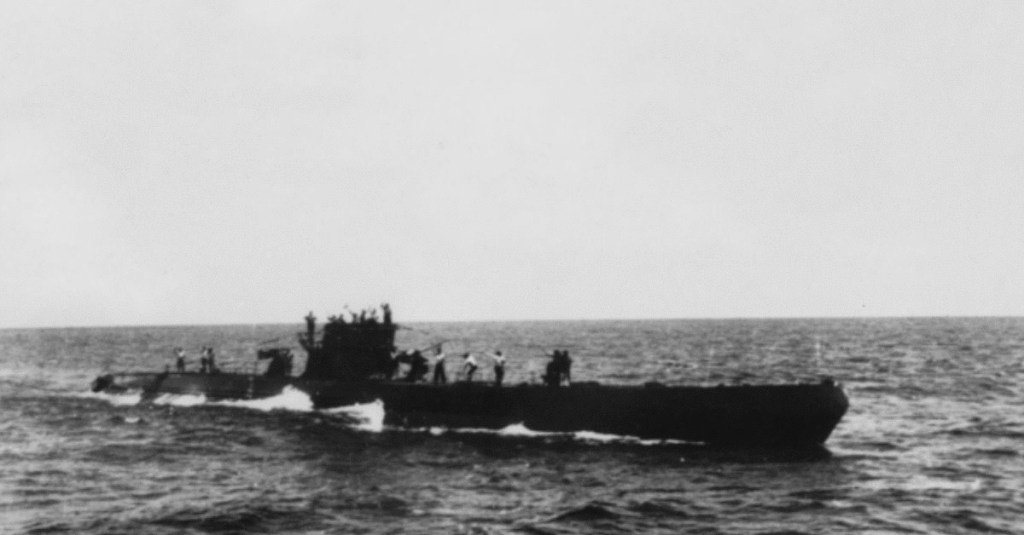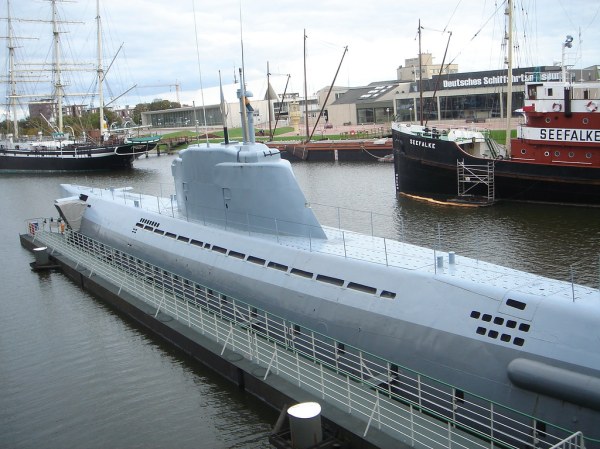The German Navy in World War II found a clever but risky method of extending their submarine patrols by building “milk cows,” specialized submarines covered in fuel tanks to refuel their brethren, and drawing the fire of American destroyer and planes.
Submarines were a game-changing weapon in World War I and remained a great strategic tool in World War II, allowing relatively few men to destroy enemy ships, drowning enemy personnel and destroying important ordnance. But they had a range problem.
The German U-461, a milk cow. It was sunk July 30, 1943, with another milk cow and an attack submarine.
The German standard in World War II was the Type VII C, which had “saddle tanks” that could hold enough fuel for a patrol of 6,500 miles, which might sound like a lot — but is actually fairly limited. U-Boats needed enough fuel to get from their pens, to the start of their patrol, through their route, and then back to the pen. Attacking ships near the U.S. east coast or the Caribbean required a 5,000-mile round trip, leaving just 1,500 miles’ worth of fuel for actually patrolling and attacking.
So, naval planners and engineers came up with a crafty solution: Turn some submarines, dubbed “milk cows,” into refuelers by strapping massive tanks to the outside, and have them refuel the other subs. The milk cows also carried medical personnel and necessary supplies.
This allowed the German submarines to move farther into the Atlantic, preying on convoys that would’ve otherwise thought they were safe. Better, it allowed the submarines to stay on patrol longer, meaning that German subs with the milk hookup were now limited only by mechanical issues. A single milk cow could tend to about 12 other subs.

The USS Cory, top right, attacks U-801, a German submarine that was attempting a linkup with the milk cow U-488, which the Cory was hunting. Cory never found U-488, which was later sunk by an aircraft from the USS Croatan in April, 1944, while attempting to link up with a boat that needed medical assistance.
(U.S. Navy)
Germany ordered 10 of them, and they became one of the most important assets in the Atlantic Ocean.
But the Americans and their allies understood how the milk cows tipped the balance, and they prioritized targeting them. The Allied Naval Headquarters in London ordered, “Get the Milk Cows at any cost!” a message that supposedly originated with Prime Minister Winston Churchill, who later said that the U-boats were his only real fear.
Once the Allies captured the German enigma machine and built up their anti-submarine warfare fleets, open season was declared on milk cows, and the milk cows were uniquely vulnerable.

The milk cow U-459 sinks after suffering an attack from an English bomber.
(Photo: Royal Air Force, Public Domain)
While they could dive deeper than other ships thanks to a thicker hull, they were more bulbous and took longer to get underwater at all. And they were larger, making them easier to spot both with the naked eye and with sonar or radar. But most importantly, they relied on high-frequency radio waves to make contact with their supported subs and set up rendezvous. Since the Allies could read those transmissions, they could crash the parties and strike the cows.
The first was sank by good luck in August 1942 when a seaplane happened over the milk cow U-464 at sea on its maiden patrol. The seaplane, a Catalina, damaged it with depth charges and radioed its position to nearby ships. The commander scuttled the boat to prevent its capture.
Open season on milk cows started the following May. The boat U-463 was spotted on the surface by a British bomber, which managed to drop a number of depth charges directly onto the ship before it could register the danger and dive. It went down with all hands.
The following June, four milk cows were sank, two of them in one battle. Boats U-461 and U-462 were working together on a single German sub when all three were spotted by Allied bombers. The bombers radioed the position and began their attack. The submarines put up a stiff resistance, but ended up prey to the 5 bombers and multiple surface ships that arrived on scene. All three sank.
By October 1943, only three milk cows remained either in the fleet or under active construction. All three would sink before the war ended.

Modern U.S. subs have no need of milk cows and can actually spend an entire cruise undersea with no resupply.
(U.S. Navy Mass Communication Specialist 1st Class Jeffrey M. Richardson)
The U.S. Navy in World War II relied on surface ships as submarine tenders, but even that role has been largely phased out as America focuses on nuclear-powered submarines that can stay at sea for months without assistance, generating their own power and cleansing their own water thanks to the nuclear reactor. They can even create their own oxygen to stay under longer.
Eventually, the ships do need fresh food, but that’s generally achieved when crews rotate out. There’s simply no need for modern milk cows.


























